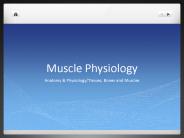Muscle Physiology - PowerPoint PPT Presentation
1 / 33
Title:
Muscle Physiology
Description:
Muscle Physiology Chapter 11 – PowerPoint PPT presentation
Number of Views:219
Avg rating:3.0/5.0
Title: Muscle Physiology
1
Muscle Physiology
- Chapter 11
2
Connective Tissue Components
- Muscle cell muscle fiber
- Endomysium covers muscle fiber
- Perimysium binds groups of muscle fibers
(fasicles) - Epimysium covers the entire muscle
- Tendon fibrous tissue that connects muscle to
bone - Aponeurosis broad, flat sheet of connective
tissue - Fascia fibrous CT surrounding muscle and tendon
3
(No Transcript)
4
General Function of Muscles
- Movement
- Excitability
- Contractility
- extensibility
- Heat Production
- Posture
5
Overview of Muscle Cell
- Muscle cell muscle fiber
- Sarcolemma plasma membrane
- Sarcoplasm cytoplasm
- Sarcoplasmic reticulum (SR) network of tubules
and sacs - Multi-nucleated, multiple mitochondrion
- Bundles of myofibrils extend lengthwise fill
sarcoplasm - Composed of thick and thin myofilaments
6
(No Transcript)
7
Sarcomere
- Contractile unit of a muscle fiber
- each myofibril consists of many sarcomeres
- Z line
- Anchors thin filaments
- Boundary of sarcomere
- M line anchors thick filaments
- A band segment of thick thin filaments
- I band segment of thin filaments
- H zone where thin and thick filaments will not
overlap (only thick)
8
(No Transcript)
9
Sarcomere cont
- Elastic filaments connect thick filaments to Z
line - T (transverse) tubules allows impulses
traveling along sarcolemma to move deeper within
the cell - Triad t tubule sandwiched between sacs of the
SR - Allows impulses traveling along a t tubule to
stimulate sacs of the SR
10
(No Transcript)
11
Myofilaments
- Myofibrils made up of 1000s of thin and thick
myofilaments - Thin filaments
- Actin
- Tropomyosin
- Troponin
- Thick filaments
- myosin
12
(No Transcript)
13
(No Transcript)
14
Muscle Excitation
- Nerve impulse reaches the end of a motor neuron ?
releases acetylcholine (Ach) - Ach diffuses across the neuromuscular junction
and binds with the receptors on the motor endplate
15
Muscle Contraction
- Impulses travel along the sarcolemma ? t tubules
? sacs of SR - Ca2 is released into the sarcoplasm ? binds with
troponin on thin myofilaments - Tropomyosin shift to expose actins active site
- Energized myosin heads bind with actins active
site and pulls thin filament towards center of
sarcomere - Requires ATP
16
(No Transcript)
17
(No Transcript)
18
Muscle Relaxation
- Nerve impulse is complete ? Ca2 is pumped back
into the sacs of the SR - Ca2 is stripped from the troponin ? tropomyosin
covers the actins active site - Myosin heads can no longer bind with actin ?
muscle fiber returns to its resting length
19
http//www.sci.sdsu.edu/movies/actin_myosin_gif.ht
ml
20
Rigor Mortis
- stiffness of death
- SR releases excess Ca2 ? myosin heads bind with
actins active sites ? contraction of
myofilaments - Lack of ATP after death causes cross bridges to
stick
21
http//highered.mcgraw-hill.com/sites/0072507470/s
tudent_view0/chapter9/
22
Sliding Filament Theory
- In fully contracted muscle
- H zone disappears
- I band narrows
- A band remains the same
23
Energy for Contractions
- Hydrolysis (breakdown) of ATP
- ATP ? ADP (breaking high energy bond btwn 2nd and
3rd phosphate groups) - ATP binds ? myosin head moves to resting position
(11-7A) - Breakdown of ATP allow myosin head to bind with
actin and perform power stroke (11-7B-D) - ATP binds to return myosin head back to resting
position
24
Alternate Source of Energy
- ATP must be continually re-synthesized
- Breakdown of creatine-phosphate (CP) provides
energy for ATP re-synthesis - Catabolism of food provides energy for ATP and CP
synthesis
25
Oxygen Glucose
- O2 and glucose are the starting materials for
cellular respiration (process that makes ATP) - During rest oxygen is stored in myoglobin
- Supplies muscle fibers with oxygen during period
of exercise - High amounts of myoglobin red fibers slow
twitch fibers - Low levels of myoglobin white fibers fast
twitch fibers
26
Aerobic vs. Anaerobic Respiration
- Aerobic Respiration
- Oxygen-requiring process
- Produces maximum amount of ATP from one glucose
molecule - Anaerobic Respiration
- Does not require oxygen
- Short-term, rapid process to re-synthesize ATP
- Produces lactic acid
- Burning/soreness in muscles
27
Heat Production
- Some energy from catabolic processes is lost as
heat - Muscle release massive amts of heat
- Thermoreceptors sense decrease in body temp ?
hypothalamus integrates information ? signal sent
to skeletal muscle to contract ? shivering ?
homeostatic balance is maintained
28
Motor Unit
- Motor unit motor neuron muscle fibers it
attaches to - Motor neurons can innervate few to 100s of muscle
fibers - A lower number of muscle fibers within a motor
unit more precise movement - Ex hand vs abdomen
29
http//natchem.files.wordpress.com/2009/11/motor-u
nit-lg.jpg
30
Isotonic vs Isometric Contractions
- Isotonic tension remains the same length of
the muscle changes - Concentric contraction muscle shortens
(contracts) - Eccentric contraction muscle lengthens
- Isometric tension changes length of the muscle
remains the same - Myosin heads unable to move thin filaments
- Static tension
31
Smooth Muscle Contractions
- Small tapered cell w/ single nuclei
- No t-tubules loosely organized SR
- No sarcomeres
- Contract to shorter lengths
- Myofilaments crisscross (balled up appearance
when contracted) - Calcium binds to calmodulin
32
http//www.cytochemistry.net/microanatomy/muscle/s
mooth1.jpg
33
Smooth Muscle Tissue Types
- 1. Visceral
- Gap junctions connect smooth muscle fibers into
sheets - Forms inner muscular layer of hollow structures
- Exhibits autorhythmicity
- Peristalsis, excretion of urine, childbirth,
mixing of stomach contents - 2. Multiunit
- Composed of many single-cell units
- Ex arrector pili muscles, lines blood vessels































